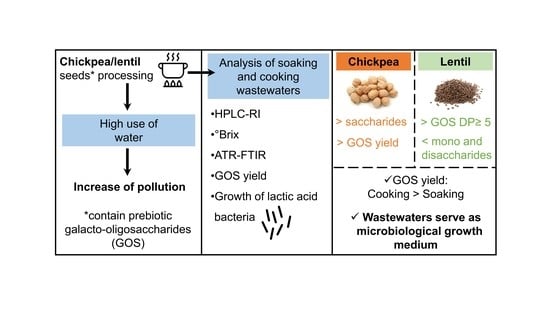Chickpeas’ and Lentils’ Soaking and Cooking Wastewaters Repurposed for Growing Lactic Acid Bacteria
Abstract
1. Introduction
2. Materials and Methods
2.1. Materials
2.2. Preparation of Legumes’ Treatment Wastewater Samples
2.3. HPLC-RI Analysis
2.4. Extraction Yield
2.5. FTIR Analysis
2.6. Microbiological Assays with Oligosaccharide Mixtures
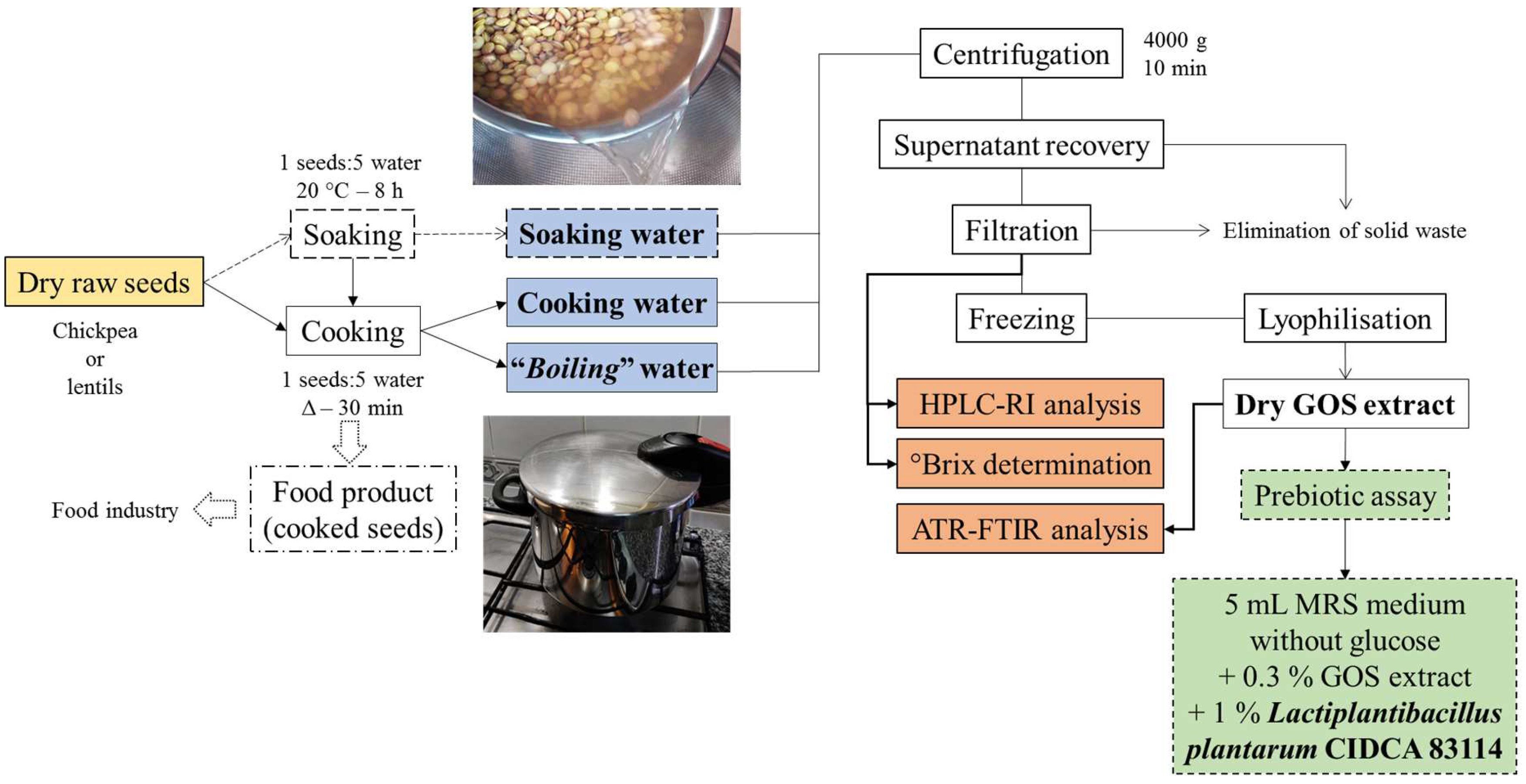
2.7. Statistical Analysis
3. Results and Discussion
3.1. HPLC-RI Results and Extraction Yield
| Compound (%) | Chickpea Extracts | Lentil Extracts | ||||
|---|---|---|---|---|---|---|
| C-SW | C-CW | C-BW | L-SW | L-CW | L-BW | |
| GOS-DP ≥ 5 | 0.01 ± 0.00 | 0.03 ± 0.00 | 0.04 ± 0.00 | 0.03 ± 0.00 | 0.08 ± 0.00 | 0.22 ± 0.00 |
| GOS-DP = 4 | 0.07 ± 0.00 | 0.26 ± 0.00 | 0.39 ± 0.01 | 0.02 ± 0.00 | 0.15 ± 0.00 | 0.49 ± 0.01 |
| GOS-DP = 3 | 0.15 ± 0.00 | 0.41 ± 0.00 | 0.59 ± 0.01 | 0.03 ± 0.00 | 0.10 ± 0.00 | 0.29 ± 0.01 |
| Lac/DP = 2 | 0.17 ± 0.00 | 0.33 ± 0.01 | 0.50 ± 0.01 | 0.01 ± 0.00 | 0.04 ± 0.00 | 0.28 ± 0.01 |
| Glu | 0.05 ± 0.00 | 0.04 ± 0.00 | 0.07 ± 0.00 | 0.02 ± 0.00 | 0.02 ± 0.00 | 0.05 ± 0.00 |
| Gal | 0.05 ± 0.00 | 0.05 ± 0.00 | 0.04 ± 0.00 | 0.00 ± 0.00 | 0.00 ± 0.00 | 0.02 ± 0.00 |
| Fru | N.D. | N.D. | N.D. | N.D. | <L.O.Q. | 0.02 ± 0.01 |
| Total GOS | 0.23 ± 0.00 b | 0.69 ± 0.01 d | 1.02 ± 0.01 f | 0.09 ± 0.00 a | 0.33 ± 0.01 c | 0.99 ± 0.01 e |
| Total mono- + disaccharides | 0.26 ± 0.01 c | 0.42 ± 0.01 e | 0.61 ± 0.02 f | 0.04 ± 0.00 a | 0.06 ± 0.00 b | 0.37 ± 0.02 d |
| Total saccharides † | 0.49 ± 0.01 c | 1.11 ± 0.01 d | 1.64 ± 0.05 f | 0.12 ± 0.00 a | 0.39 ± 0.01 b | 1.36 ± 0.04 e |
| ° Brix (total solids) | 0.5 | 1.8 | 2.8 | 0.3 | 1.0 | 3.7 |
| Compound (%) | Chickpea Extracts | Lentil Extracts | ||||
|---|---|---|---|---|---|---|
| C-SW | C-CW | C-BW | L-SW | L-CW | L-BW | |
| GOS-DP ≥ 5 | 1.62 ± 0.13 | 1.53 ± 0.02 | 1.59 ± 0.13 | 10.56 ± 0.30 | 7.92 ± 0.40 | 5.95 ± 0.10 |
| GOS-DP = 4 | 14.73 ± 0.07 | 14.24 ± 0.22 | 14.00 ± 0.37 | 7.15 ± 0.26 | 15.29 ± 0.35 | 13.13 ± 0.34 |
| GOS-DP = 3 | 29.68 ± 0.06 | 22.70 ± 0.07 | 21.10 ± 0.47 | 10.99 ± 0.47 | 9.86 ± 0.04 | 7.73 ± 0.18 |
| Lac/DP = 2 | 33.39 ± 0.35 | 18.32 ± 0.29 | 17.97 ± 0.52 | 3.88 ± 0.12 | 4.25 ± 0.24 | 7.49 ± 0.23 |
| Glu | 9.66 ± 0.55 | 2.34 ± 0.14 | 2.35 ± 0.10 | 7.35 ± 0.19 | 2.12 ± 0.09 | 1.47 ± 0.11 |
| Gal | 9.54 ± 0.27 | 2.58 ± 0.07 | 1.60 ± 0.05 | 0.44 ± 0.07 | 0.31 ± 0.01 | 0.42 ± 0.05 |
| Fru | N.D. | N.D. | N.D. | N.D. | <L.O.Q. | 0.66 ± 0.20 |
| Total GOS | 46.02 ± 0.26 f | 38.47 ± 0.31 e | 36.68 ± 0.98 d | 28.69 ± 1.03 b | 33.07 ± 0.79 c | 26.80 ± 0.61 a |
| Total mono- + disaccharides | 53.25 ± 0.22 f | 23.24 ± 0.50 e | 21.91 ± 0.67 d | 11.67 ± 0.38 c | 6.68 ± 0.34 a | 10.04 ± 0.59 b |
| Total saccharides † | 98.61 ± 1.43 e | 61.71 ± 0.81 d | 58.60 ± 1.65 c | 40.36 ± 1.41 b | 39.75 ± 1.14 b | 36.84 ± 1.20 a |
| Compound (%) | Chickpea Extracts | Lentil Extracts | ||||
|---|---|---|---|---|---|---|
| C-SW | C-CW | C-BW | L-SW | L-CW | L-BW | |
| GOS-DP ≥ 5 | 0.03 ± 0.00 | 0.10 ± 0.00 | 0.14 ± 0.01 | 0.12 ± 0.00 | 0.25 ± 0.01 | 0.35 ± 0.01 |
| GOS-DP = 4 | 0.29 ± 0.00 | 0.92 ± 0.01 | 1.21 ± 0.03 | 0.08 ± 0.00 | 0.48 ± 0.01 | 0.78 ± 0.02 |
| GOS-DP = 3 | 0.58 ± 0.00 | 1.47 ± 0.00 | 1.83 ± 0.04 | 0.13 ± 0.01 | 0.31 ± 0.00 | 0.46 ± 0.01 |
| Lac/DP = 2 | 0.65 ± 0.01 | 1.19 ± 0.02 | 1.56 ± 0.04 | 0.05 ± 0.00 | 0.13 ± 0.01 | 0.44 ± 0.01 |
| Glu | 0.19 ± 0.01 | 0.15 ± 0.01 | 0.20 ± 0.01 | 0.09 ± 0.00 | 0.07 ± 0.00 | 0.09 ± 0.01 |
| Gal | 0.19 ± 0.01 | 0.17 ± 0.00 | 0.14 ± 0.00 | 0.01 ± 0.00 | 0.01 ± 0.00 | 0.02 ± 0.00 |
| Fru | N.D. | N.D. | N.D. | N.D. | <L.O.Q. | 0.04 ± 0.01 |
| Total GOS | 0.90 ± 0.00 b | 2.49 ± 0.02 e | 3.15 ± 0.01 f | 0.34 ± 0.01 a | 1.05 ± 0.03 c | 1.59 ± 0.04 d |
| Total mono- + disaccharides | 1.04 ± 0.00 d | 1.49 ± 0.00 e | 1.87 ± 0.00 f | 0.14 ± 0.00 a | 0.21 ± 0.01 b | 0.59 ± 0.03 c |
| Total saccharides † | 1.92 ± 0.03 c | 4.00 ± 0.05 e | 5.03 ± 0.01 f | 0.47 ± 0.02 a | 1.26 ± 0.04 b | 2.18 ± 0.07 d |
3.2. FTIR
3.3. Microbiological Assay with Oligosaccharide Mixtures
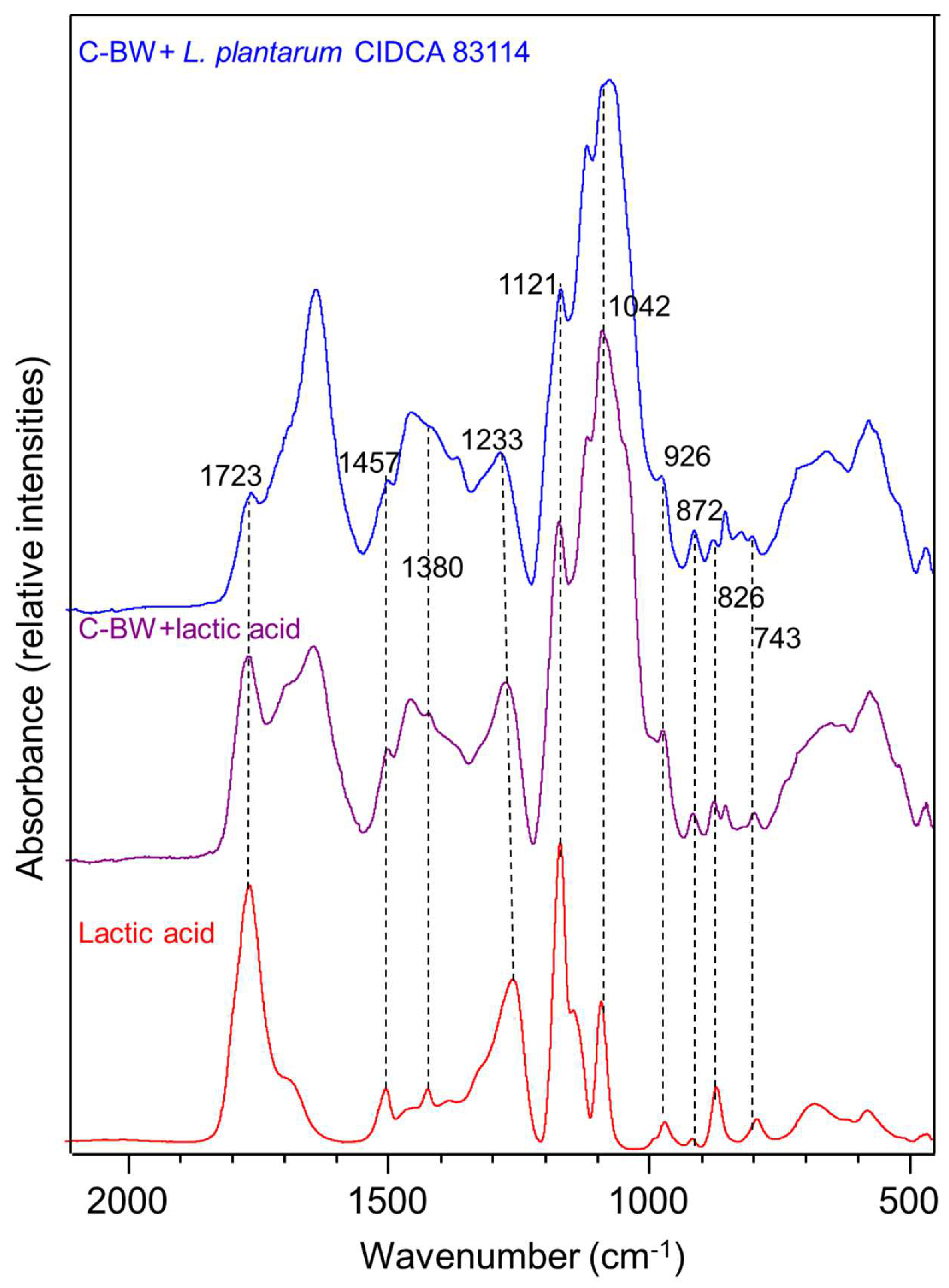
4. Conclusions
Supplementary Materials
Author Contributions
Funding
Data Availability Statement
Acknowledgments
Conflicts of Interest
References
- Kumar, Y.; Basu, S.; Goswami, D.; Devi, M.; Shivhare, U.S.; Vishwakarma, R.K. Anti-nutritional compounds in pulses: Implications and alleviation methods. Legume Sci. 2022, 4, e111. [Google Scholar] [CrossRef]
- Escobedo, A.; Mora, C.; Mojica, L. Thermal and enzymatic treatments reduced α-galactooligosaccharides in common bean (Phaseolus vulgaris L.) flour. J. Food Process. Preserv. 2019, 43, e14273. [Google Scholar] [CrossRef]
- Han, I.H.; Baik, B.K. Oligosaccharide Content and Composition of Legumes and Their Reduction by Soaking, Cooking, Ultrasound, and High Hydrostatic Pressure. Cereal Chem. 2006, 83, 428–433. [Google Scholar] [CrossRef]
- Gibson, G.R.; Hutkins, R.; Sanders, M.E.; Prescott, S.L.; Reimer, R.A.; Salminen, S.J.; Scott, K.; Stanton, C.; Swanson, K.S.; Cani, P.D.; et al. Expert consensus document: The International Scientific Association for Probiotics and Prebiotics (ISAPP) consensus statement on the definition and scope of prebiotics. Nat. Rev. Gastroenterol. Hepatol. 2017, 14, 491–502. [Google Scholar] [CrossRef] [PubMed]
- Martins, G.N.; Ureta, M.M.; Tymczyszyn, E.E.; Castilho, P.C.; Gómez-Zavaglia, A. Technological aspects of the production of fructo and galacto-oligosaccharides. Enzymatic synthesis and hydrolysis. Front. Nutr. 2019, 6, 78. [Google Scholar] [CrossRef] [PubMed]
- Njoumi, S.; Josephe Amiot, M.; Rochette, I.; Bellagha, S.; Mouquet-Rivier, C. Soaking and cooking modify the alpha-galacto-oligosaccharide and dietary fibre content in five Mediterranean legumes. Int. J. Food Sci. Nutr. 2019, 70, 551–561. [Google Scholar] [CrossRef] [PubMed]
- Mustafa, R.; Reaney, M.J.T. Aquafaba, from Food Waste to a Value-Added Product. In Food Wastes and By-Products: Nutraceutical and Health Potential, 1st ed.; Campos-Vega, R., Oomah, B.D., Vergara-Castañeda, H.A., Eds.; John Wiley & Sons Ltd.: New York, NY, USA, 2020; pp. 93–126. [Google Scholar] [CrossRef]
- Kirchherr, J.; Reike, D.; Hekkert, M. Conceptualizing the circular economy: An analysis of 114 definitions. Resour. Conserv. Recycl. 2017, 127, 221–232. [Google Scholar] [CrossRef]
- Serventi, L. Upcycling Legume Water: From Wastewater to Food Ingredients, 1st ed.; Springer International Publishing: New York, NY, USA, 2020. [Google Scholar] [CrossRef]
- Serventi, L.; Wang, S.; Zhu, J.; Liu, S.; Fei, F. Cooking water of yellow soybeans as emulsifier in gluten-free crackers. Eur. Food Res. Technol. 2018, 244, 2141–2148. [Google Scholar] [CrossRef]
- Colucci Cante, R.; Recupero, A.; Prata, T.; Nigro, F.; Passannanti, F.; Gallo, M.; Budelli, A.L. Valorisation through Lactic Fermentation of Industrial Wastewaters from a Bean Blanching Treatment. Fermentation 2023, 9, 350. [Google Scholar] [CrossRef]
- Carboni, A.D.; Martins, G.N.; Gómez-Zavaglia, A.; Castilho, P.C. Lactic Acid Bacteria in the Production of Traditional Fermented Foods and Beverages of Latin America. Fermentation 2023, 9, 315. [Google Scholar] [CrossRef]
- García-Cano, I.; Rocha-Mendoza, D.; Kosmerl, E.; Zhang, L.; Jiménez-Flores, R. Technically relevant enzymes and proteins produced by LAB suitable for industrial and biological activity. Appl. Microbiol. Biotechnol. 2020, 104, 1401–1422. [Google Scholar] [CrossRef]
- Ritter, S.W.; Gastl, M.I.; Becker, T.M. The modification of volatile and nonvolatile compounds in lupines and faba beans by substrate modulation and lactic acid fermentation to facilitate their use for legume-based beverages—A review. Compr. Rev. Food Sci. Food Saf. 2022, 21, 4018–4055. [Google Scholar] [CrossRef]
- Ruiz-Rodríguez, L.G.; Gasga, V.M.Z.; Pescuma, M.; Van Nieuwenhove, C.; Mozzi, F.; Burgos, J.A.S. Fruits and fruit by-products as sources of bioactive compounds. Benefits and trends of lactic acid fermentation in the development of novel fruit-based functional beverages. Food Res. Int. 2021, 140, 109854. [Google Scholar] [CrossRef] [PubMed]
- Vinderola, G.; Ouwehand, A.C.; Salminen, S.; Wright, A.v. Lactic Acid Bacteria—Microbiological and Functional Aspects, 5th ed.; CRC Press: Boca Raton, FL, USA, 2019. [Google Scholar] [CrossRef]
- Kakisu, E.; Bolla, P.; Abraham, A.G.; de Urraza, P.; De Antoni, G.L. Lactobacillus plantarum isolated from kefir: Protection of cultured Hep-2 cells against Shigella invasion. Int. Dairy J. 2013, 33, 22–26. [Google Scholar] [CrossRef]
- Hugo, A.A.; Kakisu, E.; De Antoni, G.L.; Pérez, P.F. Lactobacilli antagonize biological effects of enterohaemorrhagic Escherichia coli in vitro. Lett. Appl. Microbiol. 2008, 46, 613–619. [Google Scholar] [CrossRef] [PubMed]
- Friesland Campina DOMO. Vivinal® GOS PT. A Submission to the UK Food Standards Agency Requesting Consideration of Substantial Equivalence in Accordance with Regulation (EC) No 258/97 Concerning Novel Foods and Novel Food Ingredients. (Non-Confidential Version). Available online: https://acnfp.food.gov.uk/sites/default/files/gos.pdf (accessed on 13 May 2022).
- Da Figueira, O.A.S. Profile Analysis of Oligosaccharides in Yacon (Smallanthus sonchifolius) Roots—Extraction Optimization and Inulin Hydrolysis. Master’s Thesis, Universidade da Madeira, Madeira, Portugal, 2020. Available online: http://hdl.handle.net/10400.13/3143 (accessed on 9 May 2023).
- Garrote, G.L.; Abraham, A.G.; De Antoni, G.L. Chemical and microbiological characterisation of kefir grains. J. Dairy Res. 2001, 68, 639–652. [Google Scholar] [CrossRef]
- de Man, J.C.; Rogosa, M.; Sharpe, M.E. A medium for the cultivation of lactobacilli. J. Appl. Bacteriol. 1960, 23, 130–135. [Google Scholar] [CrossRef]
- USDA. FoodData Central. U.S. Department of Agriculture, 2018. Available online: https://fdc.nal.usda.gov/fdc-app.html#/food-details/172420/nutrients (accessed on 2 June 2023).
- Serventi, L. Cooking water composition. In Upcycling Legume Water: From Wastewater to Food Ingredients, 1st ed.; Springer International Publishing: New York, NY, USA, 2020; pp. 73–85. [Google Scholar]
- Liu, S.; Serventi, L. Wastewater Generation. In Upcycling Legume Water: From Wastewater to Food Ingredients, 1st ed.; Springer International Publishing: New York, NY, USA, 2020; Volume 314, pp. 13–25. [Google Scholar]
- Rico-Rodriguez, F.; Strani, L.; Grassi, S.; Lancheros, R.; Serrato, J.C.; Casiraghi, E. Study of galactooligosaccharides production from dairy waste by FTIR and chemometrics as Process Analytical Technology. Food Bioprod. Process. 2021, 126, 113–120. [Google Scholar] [CrossRef]
- Romano, N.; Santos, M.; Mobili, P.; Vega, R.; Gómez-Zavaglia, A. Effect of sucrose concentration on the composition of enzymatically synthesized short-chain fructo-oligosaccharides as determined by FTIR and multivariate analysis. Food Chem. 2016, 202, 467–475. [Google Scholar] [CrossRef]
- Romano, N.; Ureta, M.M.; Guerrero-Sánchez, M.; Gómez-Zavaglia, A. Nutritional and technological properties of a quinoa (Chenopodium quinoa Willd.) spray-dried powdered extract. Food Res. Int. 2020, 129, 108884. [Google Scholar] [CrossRef] [PubMed]
- Hong, T.; Yin, J.Y.; Nie, S.P.; Xie, M.Y. Applications of infrared spectroscopy in polysaccharide structural analysis: Progress, challenge and perspective. Food Chem. 2021, 12, 100168. [Google Scholar] [CrossRef] [PubMed]
- Oh, S.Y.; Youn, S.Y.; Park, M.S.; Baek, N.I.; Ji, G.E. Synthesis of stachyobifiose using bifidobacterial α-galactosidase purified from recombinant Escherichia coli. J. Agric. Food Chem. 2018, 66, 1184–1190. [Google Scholar] [CrossRef] [PubMed]
- The National Institute of Standards and Technology (NIST). Lactic Acid. 2018. Available online: https://webbook.nist.gov/cgi/cbook.cgi?ID=C50215&Mask=80 (accessed on 13 April 2023).
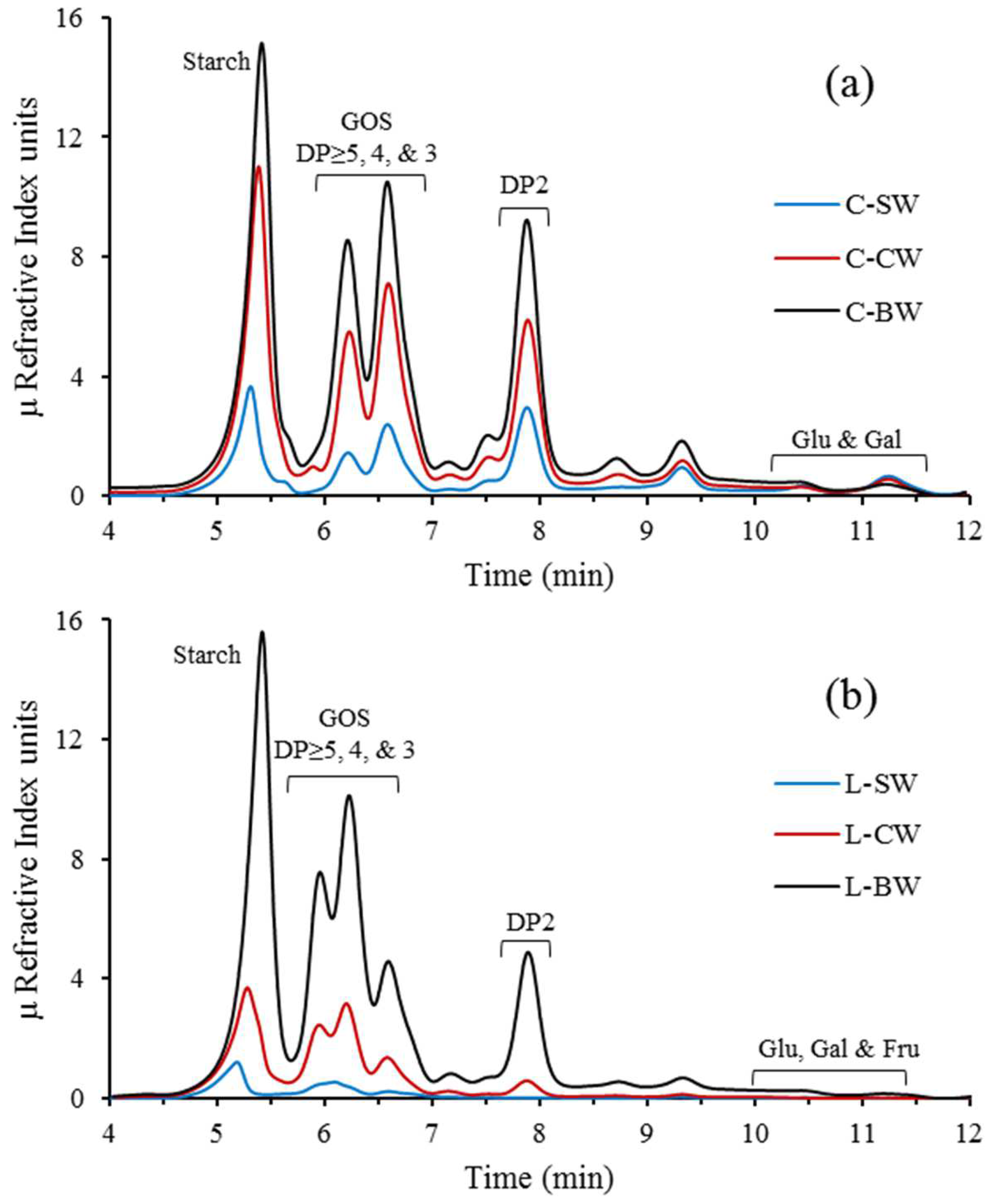
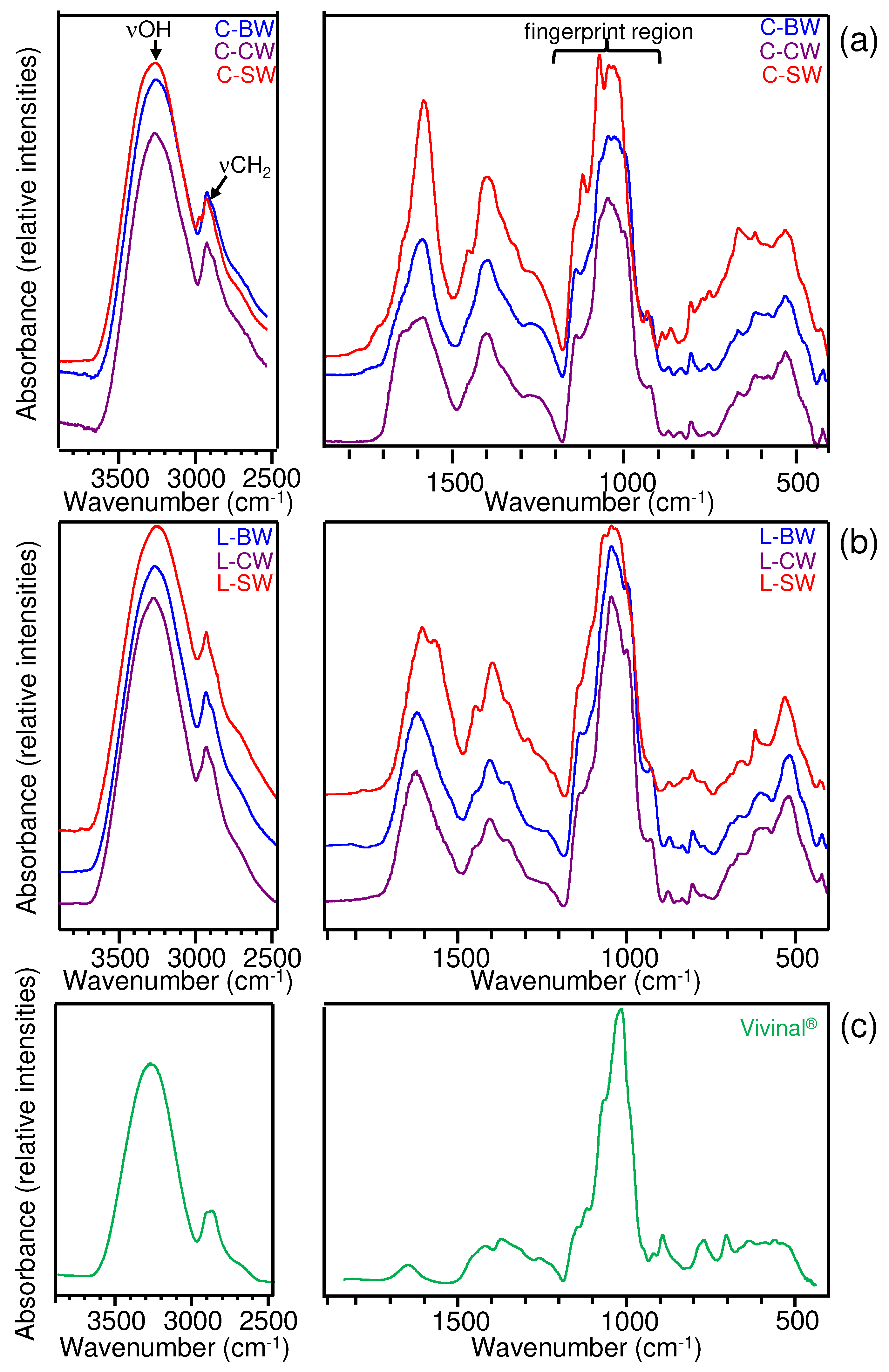
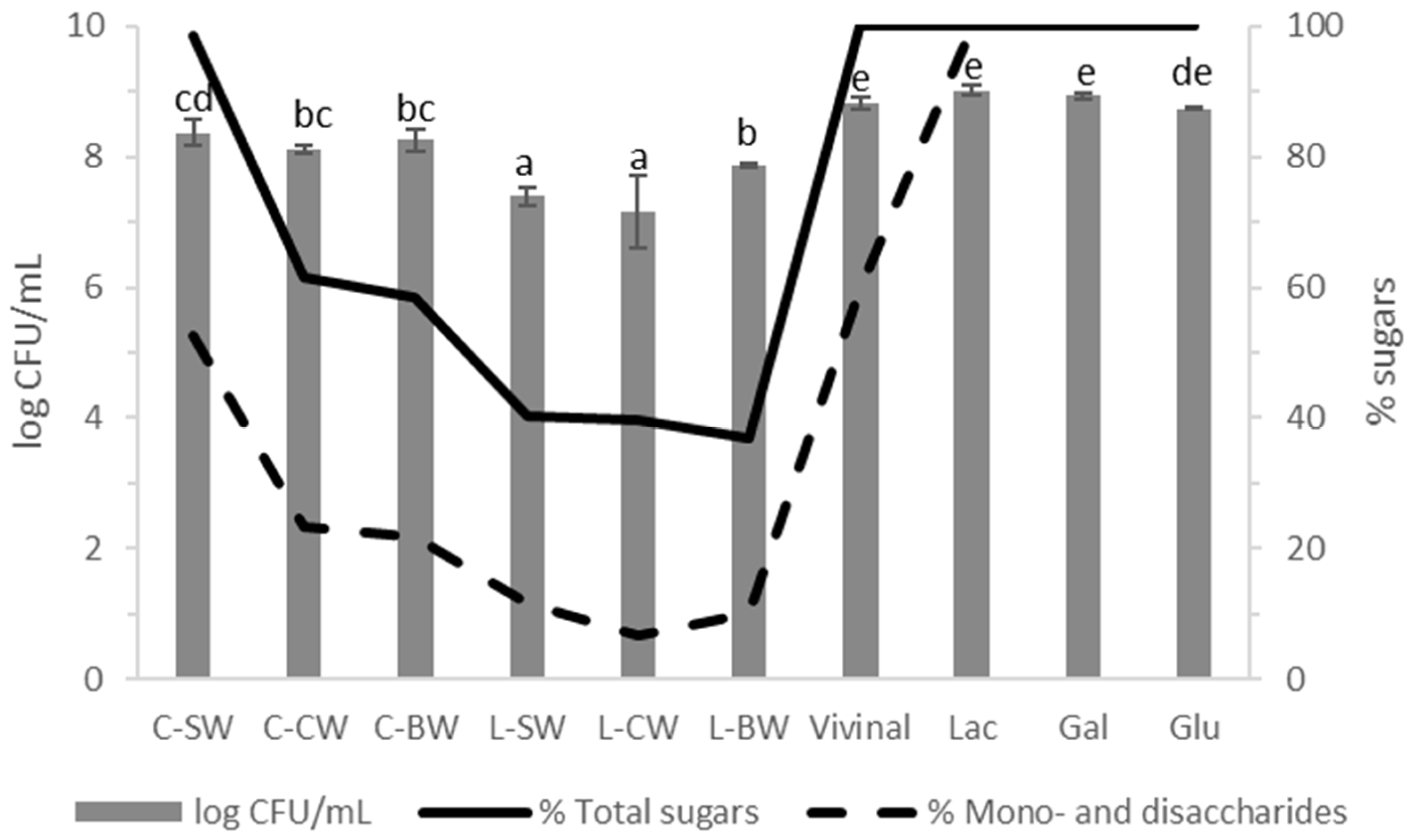
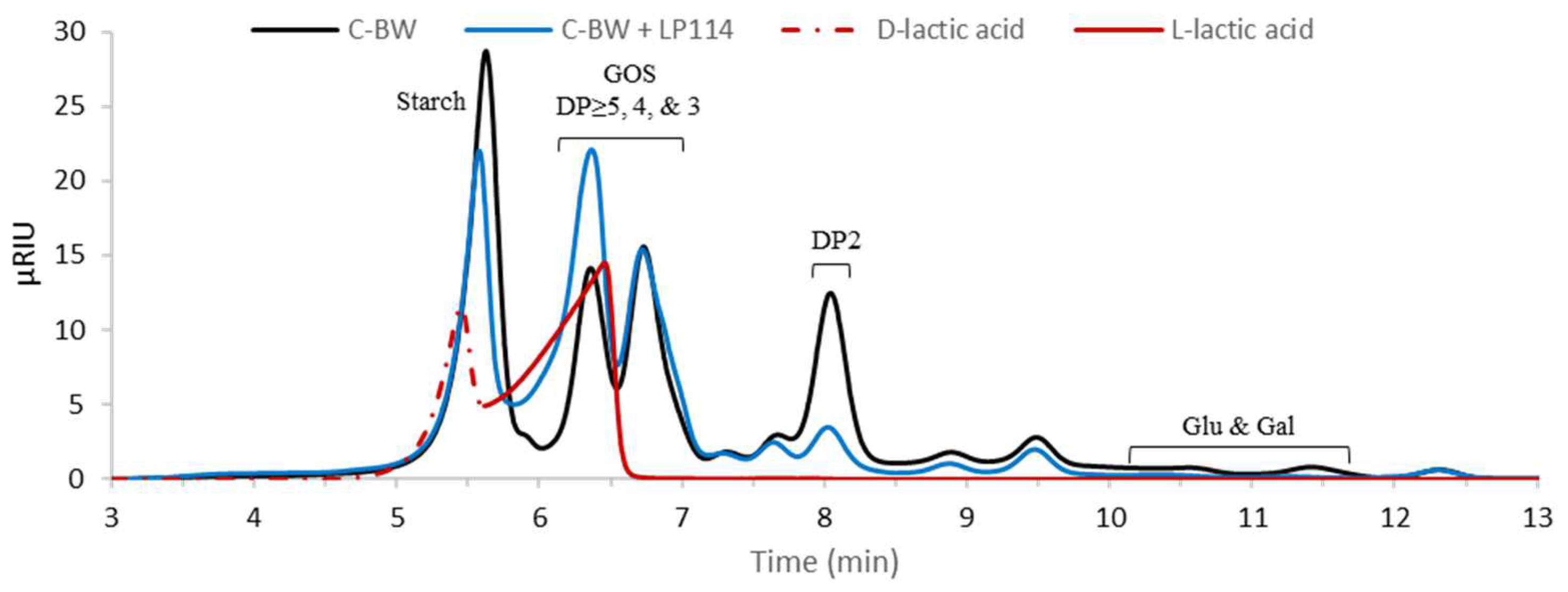
| DP7 a | DP6 a | DP5 a | DP4 | DP3 | Lac/DP2 b | Glu | Gal | Total | Total GOS c | |
|---|---|---|---|---|---|---|---|---|---|---|
| Content (%) | 7.4 | 10.8 | 22.0 | 37.4 | 21.1 | 1.3 | 100.0 | 40.2 | ||
| Retention time (min) | 5.5–5.9 | 6.4 | 7.0 | 8.1 | 10.4 | 11.2 | ||||
Disclaimer/Publisher’s Note: The statements, opinions and data contained in all publications are solely those of the individual author(s) and contributor(s) and not of MDPI and/or the editor(s). MDPI and/or the editor(s) disclaim responsibility for any injury to people or property resulting from any ideas, methods, instructions or products referred to in the content. |
© 2023 by the authors. Licensee MDPI, Basel, Switzerland. This article is an open access article distributed under the terms and conditions of the Creative Commons Attribution (CC BY) license (https://creativecommons.org/licenses/by/4.0/).
Share and Cite
Martins, G.N.; Carboni, A.D.; Hugo, A.A.; Castilho, P.C.; Gómez-Zavaglia, A. Chickpeas’ and Lentils’ Soaking and Cooking Wastewaters Repurposed for Growing Lactic Acid Bacteria. Foods 2023, 12, 2324. https://doi.org/10.3390/foods12122324
Martins GN, Carboni AD, Hugo AA, Castilho PC, Gómez-Zavaglia A. Chickpeas’ and Lentils’ Soaking and Cooking Wastewaters Repurposed for Growing Lactic Acid Bacteria. Foods. 2023; 12(12):2324. https://doi.org/10.3390/foods12122324
Chicago/Turabian StyleMartins, Gonçalo Nuno, Angela Daniela Carboni, Ayelén Amelia Hugo, Paula Cristina Castilho, and Andrea Gómez-Zavaglia. 2023. "Chickpeas’ and Lentils’ Soaking and Cooking Wastewaters Repurposed for Growing Lactic Acid Bacteria" Foods 12, no. 12: 2324. https://doi.org/10.3390/foods12122324
APA StyleMartins, G. N., Carboni, A. D., Hugo, A. A., Castilho, P. C., & Gómez-Zavaglia, A. (2023). Chickpeas’ and Lentils’ Soaking and Cooking Wastewaters Repurposed for Growing Lactic Acid Bacteria. Foods, 12(12), 2324. https://doi.org/10.3390/foods12122324








